|

The Baltimore Sun newspaper, published not far from where I grew up near Annapolis,
Maryland, carried
Flyin' Jenny from the late 1930s until the strip ended in the
mid 1940s, so I saved a couple dozen from there. The first one I downloaded has
a publication date of December 7, 1941 - that date "which will live in infamy,"
per President Roosevelt. Many Americans were receiving word over the radio of the
Japanese attack on Pearl Harbor while reading this comic at the breakfast table.
This is the January 4, 1942, Flyin' Jenny comic strip. I expect that soon there
will be World War II themes...
 As reported in this 1950 issue of Air
Trails magazine, the
19th
annual National Championship Model Airplane Contest, held at Hensley Field Air
Station in Dallas, Texas, in 1950, unfolded against a backdrop of military readiness
as Marine and Navy air units prepared for the Korean War. Despite the gravity of
the situation, more than 500 ardent contestants from the United States, Canada,
and Mexico eagerly arrived at Hensley Field, ready to participate in the first-ever
National model meet in the Southwest. For many senior flyers, aged between 18 and
21, the competition held special significance, as they were either expecting draft
notices or had already decided to enlist... As reported in this 1950 issue of Air
Trails magazine, the
19th
annual National Championship Model Airplane Contest, held at Hensley Field Air
Station in Dallas, Texas, in 1950, unfolded against a backdrop of military readiness
as Marine and Navy air units prepared for the Korean War. Despite the gravity of
the situation, more than 500 ardent contestants from the United States, Canada,
and Mexico eagerly arrived at Hensley Field, ready to participate in the first-ever
National model meet in the Southwest. For many senior flyers, aged between 18 and
21, the competition held special significance, as they were either expecting draft
notices or had already decided to enlist...
 The first thing I learned (or re-learned)
in reading this article is that in 1967, "Hertz" had only recently been assigned
as the official unit of frequency. According to Wikipedia, International Electrotechnical
Commission (IEC) adopted it in in 1930, but it wasn't until 1960 that it was adopted
by the General Conference on Weights and Measures (CGPM) (Conférence Générale des
Poids et Mesures). Hertz replace cycles per second (cps). The next thing that happened
was that I was reminded of how images such as the op-art tracing of
antenna oscillation that are routinely generated today by sophisticated
software, required huge amounts of setup time and trials to yield just a single
useful and meaningful image using actual hardware... The first thing I learned (or re-learned)
in reading this article is that in 1967, "Hertz" had only recently been assigned
as the official unit of frequency. According to Wikipedia, International Electrotechnical
Commission (IEC) adopted it in in 1930, but it wasn't until 1960 that it was adopted
by the General Conference on Weights and Measures (CGPM) (Conférence Générale des
Poids et Mesures). Hertz replace cycles per second (cps). The next thing that happened
was that I was reminded of how images such as the op-art tracing of
antenna oscillation that are routinely generated today by sophisticated
software, required huge amounts of setup time and trials to yield just a single
useful and meaningful image using actual hardware...
 This
Dremel Model
381 Moto-Tool Kit is the next generation after my Dremel Model 371 Moto-Tool
kit that my Dremel Model 370 Moto-Tool was part of. Somewhere along the line I disposed
of the plastic box that held the Moto-Tool and accessories, so I looked on eBay
for a replacement. After many years of waiting, the closest I came was this Dremel
318 Moto-Tool Kit. It appears to be identical to the Model 371, only it came with
the Dremel Moto-Tool Model 380. The Model 380 has ball bearings whereas the Model
370 uses brass bushings. This Dremel Model 381 Moto-Tool Kit appears to be in like-new
condition and looks like it has never been used. Scans of all the manual pages are
posted below in case you have been looking for them. This
Dremel Model
381 Moto-Tool Kit is the next generation after my Dremel Model 371 Moto-Tool
kit that my Dremel Model 370 Moto-Tool was part of. Somewhere along the line I disposed
of the plastic box that held the Moto-Tool and accessories, so I looked on eBay
for a replacement. After many years of waiting, the closest I came was this Dremel
318 Moto-Tool Kit. It appears to be identical to the Model 371, only it came with
the Dremel Moto-Tool Model 380. The Model 380 has ball bearings whereas the Model
370 uses brass bushings. This Dremel Model 381 Moto-Tool Kit appears to be in like-new
condition and looks like it has never been used. Scans of all the manual pages are
posted below in case you have been looking for them.
 Arch Whitehouse's air adventure stories
with wily ballistics expert and ace pilot Kerry Keen (alter ego,
The Griffon) are one of my favorite reads in the vintage Flying Aces
magazines. While testing their amphibious Black Bullet over Long Island, aviator
Kerry Keen (the Griffon) and mechanic Barney O'Dare spot a stolen experimental aircraft
- a winged fortress capable of carrying tanks. When Barney vanishes mysteriously,
Keen discovers his partner has been entangled in a plot to steal "Avalin," a revolutionary
armor formula. The trail leads to kidnapped movie star Doreen Yardley, who unknowingly
received the formula- all while protecting Keen's masked identity... Arch Whitehouse's air adventure stories
with wily ballistics expert and ace pilot Kerry Keen (alter ego,
The Griffon) are one of my favorite reads in the vintage Flying Aces
magazines. While testing their amphibious Black Bullet over Long Island, aviator
Kerry Keen (the Griffon) and mechanic Barney O'Dare spot a stolen experimental aircraft
- a winged fortress capable of carrying tanks. When Barney vanishes mysteriously,
Keen discovers his partner has been entangled in a plot to steal "Avalin," a revolutionary
armor formula. The trail leads to kidnapped movie star Doreen Yardley, who unknowingly
received the formula- all while protecting Keen's masked identity...
 This article entitled "The Boom in
R/C Boats" appeared in the June 1955 edition of Popular Electronics
magazine which, during the early years of its existence devoted quite a bit of print
space to radio control airplanes, boats and cars. As with all things electronics,
a huge surge in consumer interest was occurring with over-the-air communications.
Bill (William) Winter served as the editor of the Academy of Model Aeronautics'
(AMA's) American Modeler and American Aircraft Modeler magazines
from 1966 through 1974, but his efforts to promote all form of modeling - airplanes,
helicopters, cars, boats, trains, and rockets - covered many decades. His first
recorded article, "Building the Famous Udet Flamingo," (co-authored by Walter McBride),
was published in the March 1935 issue of Universal Model Airplane News
magazine... This article entitled "The Boom in
R/C Boats" appeared in the June 1955 edition of Popular Electronics
magazine which, during the early years of its existence devoted quite a bit of print
space to radio control airplanes, boats and cars. As with all things electronics,
a huge surge in consumer interest was occurring with over-the-air communications.
Bill (William) Winter served as the editor of the Academy of Model Aeronautics'
(AMA's) American Modeler and American Aircraft Modeler magazines
from 1966 through 1974, but his efforts to promote all form of modeling - airplanes,
helicopters, cars, boats, trains, and rockets - covered many decades. His first
recorded article, "Building the Famous Udet Flamingo," (co-authored by Walter McBride),
was published in the March 1935 issue of Universal Model Airplane News
magazine...
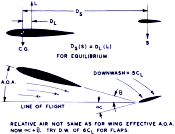 It would be interesting to do a side-by-side
comparison on what was considered engineered
control line
stunt model airplane design in 1957, when this article was written, to what
is today considered to be optimal design criteria. I am trying to get back into
control line stunt flying and have one model built currently, the Enterprise-E.
It has been flown a few times and is (was) extremely sensitive on the controls when
set up per the plans. A little bit of control handle movements resulted in a huge
amount of both elevator and flap deflection. Fortunately, access to the flap control
horn is available through the removable top fuselage hatch, so I was able to relocate
the pushrod from the bellcrank to the flap horn, and then from the flap horn... It would be interesting to do a side-by-side
comparison on what was considered engineered
control line
stunt model airplane design in 1957, when this article was written, to what
is today considered to be optimal design criteria. I am trying to get back into
control line stunt flying and have one model built currently, the Enterprise-E.
It has been flown a few times and is (was) extremely sensitive on the controls when
set up per the plans. A little bit of control handle movements resulted in a huge
amount of both elevator and flap deflection. Fortunately, access to the flap control
horn is available through the removable top fuselage hatch, so I was able to relocate
the pushrod from the bellcrank to the flap horn, and then from the flap horn...
 When Melanie and I got married in 1983,
part of her dowry included some of the toys she had as a little girl. A
Hasbro Lite-Brite
was one of them. Our kids played with it when they were young, but somewhere along
the line during our many household moves, it disappeared. We probably donated it
to the Salvation Army at some point - a lot of our stuff has ended up there. About
a month ago we started watching for a good one on eBay that didn't cost too much.
Finally, there was a 1967-vintage Lite-Brite in like-new condition up for auction
that we got for around $45. It has a nice box... When Melanie and I got married in 1983,
part of her dowry included some of the toys she had as a little girl. A
Hasbro Lite-Brite
was one of them. Our kids played with it when they were young, but somewhere along
the line during our many household moves, it disappeared. We probably donated it
to the Salvation Army at some point - a lot of our stuff has ended up there. About
a month ago we started watching for a good one on eBay that didn't cost too much.
Finally, there was a 1967-vintage Lite-Brite in like-new condition up for auction
that we got for around $45. It has a nice box...
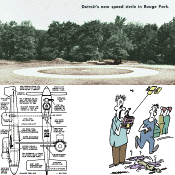 Per "Wild Bill" Netzenband's report in this
1961 issue of American Modeler magazine covered the Vancouver Bi-Liners,
MAC highlights, Alan Nichols' success in Thompson Trophy Racer events, encouraging
clubs to adopt the affordable, and slow-flying contests. He addresses backlogged
club crest submissions, noting the impracticality of featuring all due to volume.
Alan Nichols debunks the myth that models wear out quickly, citing his year-old
Nobler and a five-year-old Fierce Arrow with original engine. Memories resurface
of McDonnell Aircraft's picnic air shows, where Phil Hamm's reliable metal jet stood
out. Southern California's new Control-Line Association, led by John Gudvangan and
others, seeks enthusiasts. Detroit's Metropolitan Speed Association unveils an $8,000
Rouge Park speed circle, aiming for a competitive... Per "Wild Bill" Netzenband's report in this
1961 issue of American Modeler magazine covered the Vancouver Bi-Liners,
MAC highlights, Alan Nichols' success in Thompson Trophy Racer events, encouraging
clubs to adopt the affordable, and slow-flying contests. He addresses backlogged
club crest submissions, noting the impracticality of featuring all due to volume.
Alan Nichols debunks the myth that models wear out quickly, citing his year-old
Nobler and a five-year-old Fierce Arrow with original engine. Memories resurface
of McDonnell Aircraft's picnic air shows, where Phil Hamm's reliable metal jet stood
out. Southern California's new Control-Line Association, led by John Gudvangan and
others, seeks enthusiasts. Detroit's Metropolitan Speed Association unveils an $8,000
Rouge Park speed circle, aiming for a competitive...
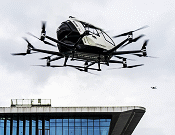 This article entitled "Why Pilots Will Matter
in the Age of
Autonomous Planes" appeared in the June 2025 issue of IEEE's Spectrum
magazine. "Long after planes start flying themselves, humans will still be in the
loop. In August 2001, an anonymous guest posted on the forum at Airliners.net, a
popular aviation website. 'How Long Will Pilots Be Needed?' they wondered, observing
that '20 years or so down the road' technology could be so advanced that planes
would fly themselves. 'So would it really be useful for a person to go to college
now and be an airline pilot if a few years down the road they will be phased out
by technology?' Twenty-four years later, the basic technology required to make aircraft
fly themselves exists, as evidenced by the fact that most commercial flights are
flown largely on autopilot..." This article entitled "Why Pilots Will Matter
in the Age of
Autonomous Planes" appeared in the June 2025 issue of IEEE's Spectrum
magazine. "Long after planes start flying themselves, humans will still be in the
loop. In August 2001, an anonymous guest posted on the forum at Airliners.net, a
popular aviation website. 'How Long Will Pilots Be Needed?' they wondered, observing
that '20 years or so down the road' technology could be so advanced that planes
would fly themselves. 'So would it really be useful for a person to go to college
now and be an airline pilot if a few years down the road they will be phased out
by technology?' Twenty-four years later, the basic technology required to make aircraft
fly themselves exists, as evidenced by the fact that most commercial flights are
flown largely on autopilot..."
 This is the February 8, 1942, "Flyin' Jenny" comic strip. The Baltimore Sun newspaper, published
not far from where I grew up near Annapolis, Maryland, carried "Flyin' Jenny" from
the late 1930s until the strip ended in the mid 1940s, so I saved a couple dozen
from there. The first one I downloaded has a publication date of December 7, 1941
- that date "which will live in infamy," per President Roosevelt. Many Americans
were receiving word over the radio of the Japanese attack on Pearl Harbor while
reading this comic at the breakfast table. I expect that soon there will be World
War II themes. "Flyin' Jenny," whose real name was Virginia Dare (what's in
a name?), was a test pilot for Starcraft Aviation Factory who divided her time between
wringing out new airplane designs and chasing bad guys. She was the creation of
artist and storyteller Russell Keaton... This is the February 8, 1942, "Flyin' Jenny" comic strip. The Baltimore Sun newspaper, published
not far from where I grew up near Annapolis, Maryland, carried "Flyin' Jenny" from
the late 1930s until the strip ended in the mid 1940s, so I saved a couple dozen
from there. The first one I downloaded has a publication date of December 7, 1941
- that date "which will live in infamy," per President Roosevelt. Many Americans
were receiving word over the radio of the Japanese attack on Pearl Harbor while
reading this comic at the breakfast table. I expect that soon there will be World
War II themes. "Flyin' Jenny," whose real name was Virginia Dare (what's in
a name?), was a test pilot for Starcraft Aviation Factory who divided her time between
wringing out new airplane designs and chasing bad guys. She was the creation of
artist and storyteller Russell Keaton...
 This is the complete set of
Peanuts Skediddlers,
sold by Mattel. Linus is extremely difficult to find, and when you do, he typically
sells for $200 or more. If you find a Linus Skediddler with the original box, expect
to pay $400. Over time, our (Melanie and me) Peanuts collection of memorabilia has
grow from the few items she had left over from her girlhood to complete sets. Everything
was gotten via eBay auctions. It took a lot of patience to be able to get good quality
items at an affordable price. Here is a bit of history I gathered on the Skediddlers.
Phenomenon: In the mid-to-late 1960s, Mattel capitalized on the explosive popularity
of Charles M. Schulz's Peanuts comic strip by releasing the Skediddler - a line
of friction-powered toys. Unlike wind-up mechanisms, these toys relied on a simple
push-and-go design: sliding them across a surface activated internal gears, causing
the characters' limbs and heads to jerk in a whimsical "skedaddling"... This is the complete set of
Peanuts Skediddlers,
sold by Mattel. Linus is extremely difficult to find, and when you do, he typically
sells for $200 or more. If you find a Linus Skediddler with the original box, expect
to pay $400. Over time, our (Melanie and me) Peanuts collection of memorabilia has
grow from the few items she had left over from her girlhood to complete sets. Everything
was gotten via eBay auctions. It took a lot of patience to be able to get good quality
items at an affordable price. Here is a bit of history I gathered on the Skediddlers.
Phenomenon: In the mid-to-late 1960s, Mattel capitalized on the explosive popularity
of Charles M. Schulz's Peanuts comic strip by releasing the Skediddler - a line
of friction-powered toys. Unlike wind-up mechanisms, these toys relied on a simple
push-and-go design: sliding them across a surface activated internal gears, causing
the characters' limbs and heads to jerk in a whimsical "skedaddling"...
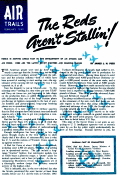 This 1949 Air Trails magazine article
warns that the
Soviet
Union has surpassed the U.S. in military aircraft production by a 15-to-1 margin,
with advanced jet fighters, bombers, and long-range piston-engine planes already
operational. Soviet scientists have also conducted atomic tests and are close to
producing compact A-bombs. Intelligence reveals a Red Air Force of 15,000 first-line
aircraft, including 2,400 jets, some surpassing American designs. The Soviets broke
the sound barrier before the U.S. and have developed powerful turbojet engines,
some with innovative features like variable-pitch stators. German scientists and
captured technology accelerated Soviet progress, particularly in rocketry and jet
propulsion. Their aircraft feature advanced construction techniques, such as metal-plywood
sandwich wings, and superior armament... This 1949 Air Trails magazine article
warns that the
Soviet
Union has surpassed the U.S. in military aircraft production by a 15-to-1 margin,
with advanced jet fighters, bombers, and long-range piston-engine planes already
operational. Soviet scientists have also conducted atomic tests and are close to
producing compact A-bombs. Intelligence reveals a Red Air Force of 15,000 first-line
aircraft, including 2,400 jets, some surpassing American designs. The Soviets broke
the sound barrier before the U.S. and have developed powerful turbojet engines,
some with innovative features like variable-pitch stators. German scientists and
captured technology accelerated Soviet progress, particularly in rocketry and jet
propulsion. Their aircraft feature advanced construction techniques, such as metal-plywood
sandwich wings, and superior armament...
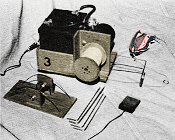 A long time ago (circa
1977) I bought a used glider winch at an auction held by the Prince Georges Radio
Club, in Maryland. It cost me somewhere around $25, which was a lot for me in the
mid 1970s. The motor and control circuitry was contained in a plywood box, with
a jack for the foot switch and terminals to clamp jumper cable to from a car. In
looking at these plans for the
AAM Glider Winch shown
here from the April 1973 American Aircraft Modeler, it looks a lot like mine, only
mine was in a wooden box. It worked extremely well for my 99"
Windfree and 99"
Aquila sailplanes. Unfortunately,
I sold it shortly after getting married in 1983 (couldn't eat the winch). I would
love to have it back. Actually, what I would rather have at this point is a winch
that is powered by a cordless drill that would be lighter... A long time ago (circa
1977) I bought a used glider winch at an auction held by the Prince Georges Radio
Club, in Maryland. It cost me somewhere around $25, which was a lot for me in the
mid 1970s. The motor and control circuitry was contained in a plywood box, with
a jack for the foot switch and terminals to clamp jumper cable to from a car. In
looking at these plans for the
AAM Glider Winch shown
here from the April 1973 American Aircraft Modeler, it looks a lot like mine, only
mine was in a wooden box. It worked extremely well for my 99"
Windfree and 99"
Aquila sailplanes. Unfortunately,
I sold it shortly after getting married in 1983 (couldn't eat the winch). I would
love to have it back. Actually, what I would rather have at this point is a winch
that is powered by a cordless drill that would be lighter...
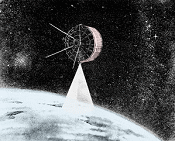 We take for granted most of the technology
that surrounds us. Unless you were alive 60 years ago at the dawn of microelectronics
and space flight, it would be difficult to imagine a world without cellphones, desktop
computers, color TVs, the Internet, and even
satellite-base weather forecasting. Everyone likes to make jokes about weathermen
being no better at predicting the weather than your grandmother's roomatiz[sic],
but the fact is that, especially for short-term (2-3 days) predictions, we get pretty
good information. As a model airplane flyer, I check the wind level forecast nearly
every day to see whether my model plane can handle it. AccuWeather's free hourly
forecast is usually pretty darn accurate for today's and tomorrow's wind... We take for granted most of the technology
that surrounds us. Unless you were alive 60 years ago at the dawn of microelectronics
and space flight, it would be difficult to imagine a world without cellphones, desktop
computers, color TVs, the Internet, and even
satellite-base weather forecasting. Everyone likes to make jokes about weathermen
being no better at predicting the weather than your grandmother's roomatiz[sic],
but the fact is that, especially for short-term (2-3 days) predictions, we get pretty
good information. As a model airplane flyer, I check the wind level forecast nearly
every day to see whether my model plane can handle it. AccuWeather's free hourly
forecast is usually pretty darn accurate for today's and tomorrow's wind...
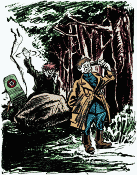 In this 1937 "Smoke Scream" in a 1937 issue
of Flying Aces magazine, by Joe Archibald,
Lt. Phineas
Pinkham, the 9th Pursuit Squadron's resident troublemaker, stumbles into chaos
when he encounters an elephant named Hungha Tin and its Hindu mahout. After the
elephant drinks a bottle of arnica meant for a local's backache, it goes berserk,
wreaking havoc across the Allied camp. Meanwhile, Brigadier Scruggs confesses to
Pinkham that he sleepwalked and handed top-secret battle plans to an unknown spy.
Pinkham, framed by the mahout - who's actually a German agent - unknowingly smokes
a drugged cigarette and nearly flies a stolen Spad to the enemy. The vengeful elephant
interrupts his forced defection, allowing Pinkham to escape with Hauptmann von Spieler
as his prisoner. Back at base, Pinkham... In this 1937 "Smoke Scream" in a 1937 issue
of Flying Aces magazine, by Joe Archibald,
Lt. Phineas
Pinkham, the 9th Pursuit Squadron's resident troublemaker, stumbles into chaos
when he encounters an elephant named Hungha Tin and its Hindu mahout. After the
elephant drinks a bottle of arnica meant for a local's backache, it goes berserk,
wreaking havoc across the Allied camp. Meanwhile, Brigadier Scruggs confesses to
Pinkham that he sleepwalked and handed top-secret battle plans to an unknown spy.
Pinkham, framed by the mahout - who's actually a German agent - unknowingly smokes
a drugged cigarette and nearly flies a stolen Spad to the enemy. The vengeful elephant
interrupts his forced defection, allowing Pinkham to escape with Hauptmann von Spieler
as his prisoner. Back at base, Pinkham...
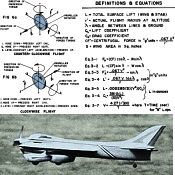 The Academy of Model Aeronautics is granted
tax-exempt status because part of its charter is for activity as an educational
organization. I think as time goes on, it gets harder for the AMA for fulfill that
part of its mission because presenting anything even vaguely resembling mathematics
or science to kids (or to most adults for that matter), is the kiss of death for
gaining or retaining interest. This article, "Control-Line
Aerodynamics Made Painless," was printed in the December 1967 edition of
American Modeler magazine, when graphs, charts, and equations were not eschewed
by modelers. It is awesome. On rare occasions a similar type article will appear
nowadays in Model Aviation magazine for topics like basic aerodynamics and battery
/ motor parameters. Nowadays, it seems, the most rigorous classroom material that
the AMA can manage to slip into schools is a box of gliders and a PowerPoint presentation... The Academy of Model Aeronautics is granted
tax-exempt status because part of its charter is for activity as an educational
organization. I think as time goes on, it gets harder for the AMA for fulfill that
part of its mission because presenting anything even vaguely resembling mathematics
or science to kids (or to most adults for that matter), is the kiss of death for
gaining or retaining interest. This article, "Control-Line
Aerodynamics Made Painless," was printed in the December 1967 edition of
American Modeler magazine, when graphs, charts, and equations were not eschewed
by modelers. It is awesome. On rare occasions a similar type article will appear
nowadays in Model Aviation magazine for topics like basic aerodynamics and battery
/ motor parameters. Nowadays, it seems, the most rigorous classroom material that
the AMA can manage to slip into schools is a box of gliders and a PowerPoint presentation...
|
The Airplanes and Rockets Homepage Archive
is a comprehensive collection of every item appearing daily on this website since
2017 - and many from earlier years.
 Website visitor Mark Radcliff (yes, THE
Mark Radcliff, of 75-77-79-81 USA F3a RC Aerobatic Team fame, and until recently,
VP of that AMA's District III) wrote to request that I scan the article for
Steve Wooley's control
line Argus, which, appeared in the August 1961 American Modeler magazine. The
Argus was the star of the 1960 world championships in Hungary. Note the unique wing
construction where rather than using full ribs, upper and lower outlines are used
that sit over and under the beefy solid wing spar. The entire article is very short... Website visitor Mark Radcliff (yes, THE
Mark Radcliff, of 75-77-79-81 USA F3a RC Aerobatic Team fame, and until recently,
VP of that AMA's District III) wrote to request that I scan the article for
Steve Wooley's control
line Argus, which, appeared in the August 1961 American Modeler magazine. The
Argus was the star of the 1960 world championships in Hungary. Note the unique wing
construction where rather than using full ribs, upper and lower outlines are used
that sit over and under the beefy solid wing spar. The entire article is very short...
 The Douglas Aircraft Company's
DC−4 conducted its maiden flight on June 7, 1938. It was a hugely successful
four-engined aircraft used for civilian and military passenger and cargo transportation.
Military versions of the plane were designated C−54 and R5D. The DC−4 was designed
to be the airline industry's "dream" airplane - "a Grand Hotel with wings", capable
of cruise speeds of more than two hundred miles per hour and a range of 3,300 miles,
making it capable of non-stop coast-to-coast flight. Although the DC−4 was the brainchild
of United Airlines, a consortium of five companies - United, TWA, American, Eastern
and Pan American - financed the endeavor to ensure success would not be hampered
due to cost and competition concerns. The airplane's control systems were so complex
that a new crew member position called "flight engineer" was created to monitor
and tend to all the meters, dials, knobs, switches, and panel lights, while allowing
the pilots to worry mostly about flying... The Douglas Aircraft Company's
DC−4 conducted its maiden flight on June 7, 1938. It was a hugely successful
four-engined aircraft used for civilian and military passenger and cargo transportation.
Military versions of the plane were designated C−54 and R5D. The DC−4 was designed
to be the airline industry's "dream" airplane - "a Grand Hotel with wings", capable
of cruise speeds of more than two hundred miles per hour and a range of 3,300 miles,
making it capable of non-stop coast-to-coast flight. Although the DC−4 was the brainchild
of United Airlines, a consortium of five companies - United, TWA, American, Eastern
and Pan American - financed the endeavor to ensure success would not be hampered
due to cost and competition concerns. The airplane's control systems were so complex
that a new crew member position called "flight engineer" was created to monitor
and tend to all the meters, dials, knobs, switches, and panel lights, while allowing
the pilots to worry mostly about flying...
 These couple
vintage model
aviation comics appeared in the May 1957 issue of the Academy of Model Aeronautics'
American Modeler magazine. The one on page 8 might need some explanation in order
"get it." Back in the era, aviation of all sorts - both model and full-size - was
still a novelty for most people. When either type of aircraft was seen close to
the ground where people could get up-close looks, a crowd would often gather. In
this comic, a huge group of people stopped to watch the model airplane fly, so the
modeler decided it was his civic duty to provide a show for the onlookers. Many
decades ago, comic strips had a very broad appeal with people. Daily newspapers
and magazines often carried a large variety of single pane comics and strip comics... These couple
vintage model
aviation comics appeared in the May 1957 issue of the Academy of Model Aeronautics'
American Modeler magazine. The one on page 8 might need some explanation in order
"get it." Back in the era, aviation of all sorts - both model and full-size - was
still a novelty for most people. When either type of aircraft was seen close to
the ground where people could get up-close looks, a crowd would often gather. In
this comic, a huge group of people stopped to watch the model airplane fly, so the
modeler decided it was his civic duty to provide a show for the onlookers. Many
decades ago, comic strips had a very broad appeal with people. Daily newspapers
and magazines often carried a large variety of single pane comics and strip comics...
 Whilst waiting for the Canadian snow to
subside, Steven built a second Ace Whizard, this time with a cox TeeDee .049
engine and a separate 2 0z. fuel tank. That should extend the flight time from
2-3 minutes with the Black Widow .049 to 8-10 minutes. The TeeDee should provide
a little more power as well. The Whizard began appear in Ace R/C advertisements
around 1974. See Steven's building article that has lots of good photos ... Whilst waiting for the Canadian snow to
subside, Steven built a second Ace Whizard, this time with a cox TeeDee .049
engine and a separate 2 0z. fuel tank. That should extend the flight time from
2-3 minutes with the Black Widow .049 to 8-10 minutes. The TeeDee should provide
a little more power as well. The Whizard began appear in Ace R/C advertisements
around 1974. See Steven's building article that has lots of good photos ...
 Here is Melanie with my vintage, circa 1967
Sears "Discoverer" Model 4 6305A 60 mm Equatorial
Refractor Telescope (focal length 900 mm, f15 optics). Purchased
on eBay for a very reasonable price, it was in excellent condition optically and
physically. There are a few minor paint scratches that I plan to repair. After disassembling
all the mechanical parts, cleaning, greasing, and reassembling them, operation is
very smooth. The sun projection screen will come in handy for the April 2024 total
solar eclipse, and incredibly enough my house in Erie, Pennsylvania sits almost
dead center in the path of totality. The shipping / carrying case came with the
telescope. It is constructed with a mahogany plywood top and bottom surface and
with solid mahogany frame pieces. All the hardware was removed and either polished
or painted. The wood was sanded just enough to get it smooth and remove a couple
very minor scratches. I was careful to not erase any of the original already faded
ink stamping on the inside bottom; it has "JAS," with the rest being Japanese. Then,
three coats of semigloss polyurethane ... Here is Melanie with my vintage, circa 1967
Sears "Discoverer" Model 4 6305A 60 mm Equatorial
Refractor Telescope (focal length 900 mm, f15 optics). Purchased
on eBay for a very reasonable price, it was in excellent condition optically and
physically. There are a few minor paint scratches that I plan to repair. After disassembling
all the mechanical parts, cleaning, greasing, and reassembling them, operation is
very smooth. The sun projection screen will come in handy for the April 2024 total
solar eclipse, and incredibly enough my house in Erie, Pennsylvania sits almost
dead center in the path of totality. The shipping / carrying case came with the
telescope. It is constructed with a mahogany plywood top and bottom surface and
with solid mahogany frame pieces. All the hardware was removed and either polished
or painted. The wood was sanded just enough to get it smooth and remove a couple
very minor scratches. I was careful to not erase any of the original already faded
ink stamping on the inside bottom; it has "JAS," with the rest being Japanese. Then,
three coats of semigloss polyurethane ...
 Here is another set of model aviation-themed
comics, this time from the November 1953 issue of Air Trails magazine.
Interestingly, the middle comics mentions an "X-115" experimental airplane that
claims to be able to hit 850 miles per hour. It seems to be an obvious allusion
to the North American
X-15
airplane, which on its first light on June 8, 1959 was flown by Scott Crossfield
to a speed 840 kilometer per hour. Mach 0.79 = 522 mi/hr, Mach 1 = 1,235 km/hr
= 767 mi/hr. The two numbers are amazing close, although the units are different.
There is a list at the bottom of the page with links to all the model aviation-themed
comics I have scanned and posted so far. Enjoy! Here is another set of model aviation-themed
comics, this time from the November 1953 issue of Air Trails magazine.
Interestingly, the middle comics mentions an "X-115" experimental airplane that
claims to be able to hit 850 miles per hour. It seems to be an obvious allusion
to the North American
X-15
airplane, which on its first light on June 8, 1959 was flown by Scott Crossfield
to a speed 840 kilometer per hour. Mach 0.79 = 522 mi/hr, Mach 1 = 1,235 km/hr
= 767 mi/hr. The two numbers are amazing close, although the units are different.
There is a list at the bottom of the page with links to all the model aviation-themed
comics I have scanned and posted so far. Enjoy!
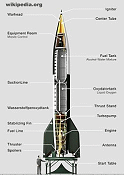 This
article by science fiction writer Arthur C. Clarke, of 2001: A Space Odyssey fame,
suggested the use of surplus German V−2 (Vergeltungswaffe 2; i.e., Retribution Weapon 2) rockets for launching
scientific payloads into space rather than for launching terrorizing attacks on
European cities. The October 1945 publishing date was after Germany had surrendered
in the spring of that year and Allied forces were rounding up war criminals and
confiscating documents and equipment. Clarke describes how an "artificial satellite"
could be caused to circle the earth "perpetually" and was published in the October
1945 edition of Wireless World magazine. The pilot-less V−2, along with
the V−1 "Buzz Bomb," were launched from within Germany and caused massive structural
damage and human death and suffering. For war progenitor and aggressor, Germany,
to call it a retribution weapon was a gross misnomer, especially considering it
was the second time (WWI and WWII) in three decades that the country had attempted
to bring Europe under its dominance with brutal assaults... This
article by science fiction writer Arthur C. Clarke, of 2001: A Space Odyssey fame,
suggested the use of surplus German V−2 (Vergeltungswaffe 2; i.e., Retribution Weapon 2) rockets for launching
scientific payloads into space rather than for launching terrorizing attacks on
European cities. The October 1945 publishing date was after Germany had surrendered
in the spring of that year and Allied forces were rounding up war criminals and
confiscating documents and equipment. Clarke describes how an "artificial satellite"
could be caused to circle the earth "perpetually" and was published in the October
1945 edition of Wireless World magazine. The pilot-less V−2, along with
the V−1 "Buzz Bomb," were launched from within Germany and caused massive structural
damage and human death and suffering. For war progenitor and aggressor, Germany,
to call it a retribution weapon was a gross misnomer, especially considering it
was the second time (WWI and WWII) in three decades that the country had attempted
to bring Europe under its dominance with brutal assaults...
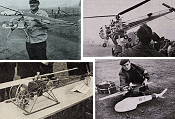 $25 R/C helicopters are available from Amazon
that climb and turn on demand (kinda). For under $60 you get a fully controllable
model with counter-rotating rotors that anyone can fly like a pro in after an hour
or two of practice. Double that amount and a 3-D-capable, ready-to-fly helicopter
is available to you, complete with a spread spectrum radio, gyro stabilization,
a brushless motor, and Li-Poly batteries... with a computerized charger. Engineers
have labored endlessly to bring this state of the art technology to all corners
of the world. It was not that way all so long ago. To wit, take a look at this article
from the March 1969 edition of American Aircraft Modeler magazine, that
reported on Germany's first ever R/C helicopter competition that was held
in the fall of 1968. There were no kits (let alone RFTs), no special heli engines,
no gyroscopes, no carbon fiber blades, to "how-to" manuals, not even any reserved
frequencies for the newly arrived proportional radio control systems. All helicopters
there were designed and built from scratch, and no two looked alike; large number
or unique color schemes were not necessary to keep track of a cookie-cutter production
craft... $25 R/C helicopters are available from Amazon
that climb and turn on demand (kinda). For under $60 you get a fully controllable
model with counter-rotating rotors that anyone can fly like a pro in after an hour
or two of practice. Double that amount and a 3-D-capable, ready-to-fly helicopter
is available to you, complete with a spread spectrum radio, gyro stabilization,
a brushless motor, and Li-Poly batteries... with a computerized charger. Engineers
have labored endlessly to bring this state of the art technology to all corners
of the world. It was not that way all so long ago. To wit, take a look at this article
from the March 1969 edition of American Aircraft Modeler magazine, that
reported on Germany's first ever R/C helicopter competition that was held
in the fall of 1968. There were no kits (let alone RFTs), no special heli engines,
no gyroscopes, no carbon fiber blades, to "how-to" manuals, not even any reserved
frequencies for the newly arrived proportional radio control systems. All helicopters
there were designed and built from scratch, and no two looked alike; large number
or unique color schemes were not necessary to keep track of a cookie-cutter production
craft...
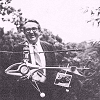 Du-Bro's Whirlybird 505 was the first successful
commercial helicopter kit (although successful is a relative term as applied here).
I was fortunate as a kid in Holly Hill Harbor, Mayo, Maryland, because there was
a man down the street from me who was an avid radio control modeler and seemed to
buy just about every new type of radio, engine, and kit available. I would anxiously
await the sound of an engine running, and instantly jump on my bicycle to ride down
and see what he was doing. The strange thing about it was that he had three step-sons
who were notoriously bad actors who counted it as sport to harass and occasionally
beat up guys like me, so I always approached the yard with a bit of trepidation.
The gentleman himself was very nice, and a few times even gave me... Du-Bro's Whirlybird 505 was the first successful
commercial helicopter kit (although successful is a relative term as applied here).
I was fortunate as a kid in Holly Hill Harbor, Mayo, Maryland, because there was
a man down the street from me who was an avid radio control modeler and seemed to
buy just about every new type of radio, engine, and kit available. I would anxiously
await the sound of an engine running, and instantly jump on my bicycle to ride down
and see what he was doing. The strange thing about it was that he had three step-sons
who were notoriously bad actors who counted it as sport to harass and occasionally
beat up guys like me, so I always approached the yard with a bit of trepidation.
The gentleman himself was very nice, and a few times even gave me...
 For some odd reason the venue for the
1954 F.A.I. World Model Air Olympics was not mentioned in this pictorial featured
in the November 1954 issue of Air Trails magazine. However, an article appeared
in the July 27, 1954 edition of The New York Times newspaper stating that the event
took place at Suffolk County Air Force Base in New York state. The 1955 event also
occurred there according to this 1955 Air Trails article entitled "International
Meets: Rubber Power Wakefield F.A.I. Free Flight 'Gas'." Do you recognize anyone
here? For some odd reason the venue for the
1954 F.A.I. World Model Air Olympics was not mentioned in this pictorial featured
in the November 1954 issue of Air Trails magazine. However, an article appeared
in the July 27, 1954 edition of The New York Times newspaper stating that the event
took place at Suffolk County Air Force Base in New York state. The 1955 event also
occurred there according to this 1955 Air Trails article entitled "International
Meets: Rubber Power Wakefield F.A.I. Free Flight 'Gas'." Do you recognize anyone
here?
 Back in the early to mid 1970s, I built a
Sterling Cirrus sailplane kit. Shortly thereafter
I bought my first radio control system (a used
3-channel OS Digitron),
and in a somewhat desperate attempt to fly an RC glider, actually managed to cram
two of its huge servos, a huge metal-cased receiver, and a NiCad airborne battery
pack (the only part that has not gotten smaller in the intervening 50 years) into
the cockpit area. Although the cockpit was very spacious, the balsa frame construction
was way too weak to support a radio system, but that didn't stop me... well, not
right away anyway. The ready-to-fly weight was probably three times the recommended
12 ounce nominal. Although the Cirrus has a generous 87-5/16" wingspan, with it
25:1 aspect ratio, the root chord is only a little over 4" and the wingtip chord
is around 1". Even with vertical sheer webbing between the upper and lower main
spars, the wing was far too weak for so much weight. After much work covering the
undercambered airfoil and compound curves around the fuselage with Japanese tissue
and brushing on a few coats of clear dope, it was finally ready to fly... Back in the early to mid 1970s, I built a
Sterling Cirrus sailplane kit. Shortly thereafter
I bought my first radio control system (a used
3-channel OS Digitron),
and in a somewhat desperate attempt to fly an RC glider, actually managed to cram
two of its huge servos, a huge metal-cased receiver, and a NiCad airborne battery
pack (the only part that has not gotten smaller in the intervening 50 years) into
the cockpit area. Although the cockpit was very spacious, the balsa frame construction
was way too weak to support a radio system, but that didn't stop me... well, not
right away anyway. The ready-to-fly weight was probably three times the recommended
12 ounce nominal. Although the Cirrus has a generous 87-5/16" wingspan, with it
25:1 aspect ratio, the root chord is only a little over 4" and the wingtip chord
is around 1". Even with vertical sheer webbing between the upper and lower main
spars, the wing was far too weak for so much weight. After much work covering the
undercambered airfoil and compound curves around the fuselage with Japanese tissue
and brushing on a few coats of clear dope, it was finally ready to fly...
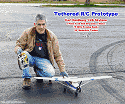 For a long time I have been kicking around
the concept of tethered
R/C, where the airplane would be completely under remote control, with its inboard
wing being attached to a tether that is in turn anchored to a pivot point in the
center of the circle. My first effort was to convert an electric-powered control
line stunt model to have R/C control of the elevator and motor speed. After doing
the conversion, I decided that it would be safer to start out with a slow-flying,
inherently stable model, so since I was in the process of building an electric-powered,
three channel Carl Goldberg ½A Skylane, it was used as the Guiney pig. The steerable
nose gear was pegged in the center, and the rudder pushrod was secured with a screw
in the servo mount so that it has permanent right rudder. A tether attachment point
was epoxied into the left wingtip. It weights 25.3 ounces ready to fly. The
wing chord was increased by about 0.5" over the plans outline in order to get a
little more area and decrease the wing loading a tab bit... For a long time I have been kicking around
the concept of tethered
R/C, where the airplane would be completely under remote control, with its inboard
wing being attached to a tether that is in turn anchored to a pivot point in the
center of the circle. My first effort was to convert an electric-powered control
line stunt model to have R/C control of the elevator and motor speed. After doing
the conversion, I decided that it would be safer to start out with a slow-flying,
inherently stable model, so since I was in the process of building an electric-powered,
three channel Carl Goldberg ½A Skylane, it was used as the Guiney pig. The steerable
nose gear was pegged in the center, and the rudder pushrod was secured with a screw
in the servo mount so that it has permanent right rudder. A tether attachment point
was epoxied into the left wingtip. It weights 25.3 ounces ready to fly. The
wing chord was increased by about 0.5" over the plans outline in order to get a
little more area and decrease the wing loading a tab bit...
 In looking at this advertisement by
Douglas Model Distributors in the September 1949 issue of Air Trails
magazine, you might wonder what type of models Douglas was distributing. Of course
if you want to sell products and service to men (and boys), one of the best gimmicks
to use is a pretty - and shapely - girl (see the AeroGloss ad also on the page).
Marketeers have been onto that angle since the dawn of civilization. The company
was located in Salt Lake City, Utah, at the time of this advertisement, but a search
for Douglas Model Distributors shows they are now (if it is the same company) set
up in Liberty, Missouri. On their webpage there is a note about their retail distributor
business called Sprue Brothers Models, which is funny because a "sprue" is the little
section of plastic on a model kit injection molded parts tree that connects the
parts to the tree. I'm guessing the company name is a play on the process... In looking at this advertisement by
Douglas Model Distributors in the September 1949 issue of Air Trails
magazine, you might wonder what type of models Douglas was distributing. Of course
if you want to sell products and service to men (and boys), one of the best gimmicks
to use is a pretty - and shapely - girl (see the AeroGloss ad also on the page).
Marketeers have been onto that angle since the dawn of civilization. The company
was located in Salt Lake City, Utah, at the time of this advertisement, but a search
for Douglas Model Distributors shows they are now (if it is the same company) set
up in Liberty, Missouri. On their webpage there is a note about their retail distributor
business called Sprue Brothers Models, which is funny because a "sprue" is the little
section of plastic on a model kit injection molded parts tree that connects the
parts to the tree. I'm guessing the company name is a play on the process...
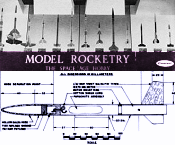 G. Harry Stine was (and in some places
still is) a household word (ok, a letter and two words) amongst people who engage
in model rocketry. As a degreed physicist, he spent his professional years working
in both civilian and government aerospace projects. In his spare time, Mr. Stine
contributed mightily to the science, industry, and sport of model rocketry. His
monthly columns in American Aircraft Modeler magazine were read and appreciated
by enthusiasts hungry for a regular helping of the technical side of the craft,
served in layman's terms. A typical article written by him reports on some happenings
in the trade show and contest realms, while including a lesson in
model rocket design and flight... G. Harry Stine was (and in some places
still is) a household word (ok, a letter and two words) amongst people who engage
in model rocketry. As a degreed physicist, he spent his professional years working
in both civilian and government aerospace projects. In his spare time, Mr. Stine
contributed mightily to the science, industry, and sport of model rocketry. His
monthly columns in American Aircraft Modeler magazine were read and appreciated
by enthusiasts hungry for a regular helping of the technical side of the craft,
served in layman's terms. A typical article written by him reports on some happenings
in the trade show and contest realms, while including a lesson in
model rocket design and flight...
 These "Sketchbook"
pages appeared for many years in Air Trails Hobbies for Young Men magazine
and in its predecessor, Air Trails. "Sketchbook" was a monthly feature
where modelers wrote to the magazine with handy ideas for saving time and/or money,
and just for offering tips and suggestions on a different way of doing something.
Prior to having information on just about every topic readily available on the Internet,
modelers had to rely on books, magazines, friends, and personal ingenuity. Also,
in those days there was not the plethora of accessories available for building models,
so a lot of creativity was involved. Even items as commonplace as bellcranks for
control line models and dethermalizers for free flight were fabricated from salvaged
parts like metal soup cans and hairpins. I'm guessing no magazine today would dare
publish a scheme to attach bottle rockets to a model airplane as is shown here,
lest Homeland Security or the FBI show up at the editor's door in the early morning
hours with a fully outfitted SWAT team... These "Sketchbook"
pages appeared for many years in Air Trails Hobbies for Young Men magazine
and in its predecessor, Air Trails. "Sketchbook" was a monthly feature
where modelers wrote to the magazine with handy ideas for saving time and/or money,
and just for offering tips and suggestions on a different way of doing something.
Prior to having information on just about every topic readily available on the Internet,
modelers had to rely on books, magazines, friends, and personal ingenuity. Also,
in those days there was not the plethora of accessories available for building models,
so a lot of creativity was involved. Even items as commonplace as bellcranks for
control line models and dethermalizers for free flight were fabricated from salvaged
parts like metal soup cans and hairpins. I'm guessing no magazine today would dare
publish a scheme to attach bottle rockets to a model airplane as is shown here,
lest Homeland Security or the FBI show up at the editor's door in the early morning
hours with a fully outfitted SWAT team... |